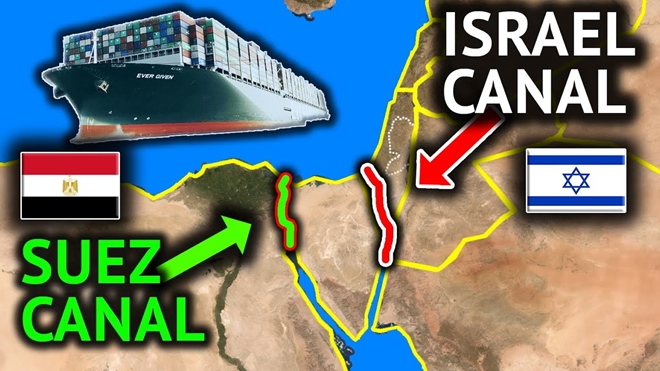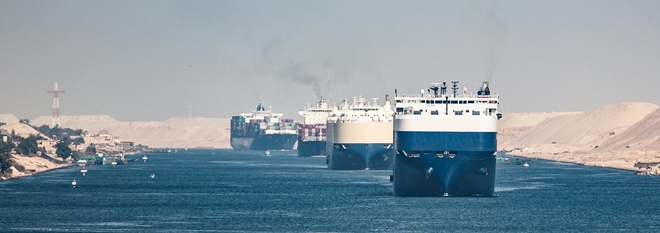Without the Suez Canal… what would the world be like?
However, the Ever Given stranding raises a question: If such an unexpected incident happened again, wouldn’t the world still have to wait for a successful rescue operation?
West Coast, and… Arctic Ocean
One thing is easy to see: When the dedicated Egyptian dredging workers “worked day and night” to bring the 400-meter-long and 220,000-ton vessel back to the ocean, they not only forgot to eat or sleep. because the Suez Canal is one of the greatest prides of their country, not only because 9 billion dollars of goods are jammed every day, but because the traffic of ships on the Suez Canal is closely related. to their own bread and butter. As Eslam Negm – an Egyptian sailor involved in dredging – shared: “We – that is, the majority of Egyptians – live by this canal.”
Since then, without the need for exact data, anyone can imagine the huge profit that this arterial shipping route brings. And so it is not surprising that there are immediately alternatives to the Suez Canal (or at least contingency for the worst-case scenario) proposed in the media. international mass media.
At the forefront is Israel. According to The Arab Weekly on March 30, 2021, the Suez Canal blockage event has sparked discussion of Suez alternatives – including Israel’s Ben Gurion canal project connecting the Red Sea. with the Mediterranean (aka the Israel Canal) – comes alive.
The Israelis consider this route a competitor of the Suez Canal. Tel Aviv plans to turn the Israel Canal into a multifaceted project, such as building small towns, hotels, restaurants and nightclubs around this waterway.

Outline of the Israeli canal project.
Previously, on March 25, 2021, Business Insider (USA) published the contents of a secret memo written in 1963, declassified in 1996. Accordingly, the country’s Lawrence Livermore National Laboratory The United States has worked on a project to use nuclear explosions to dig a 160-mile (257 km) long canal through the Negev desert in Israel, connecting the Mediterranean with the Gulf of Aqaba on the Red Sea (Red Sea).
Historian Alex Wellerstein – who also mentioned the profile on his personal Twitter social networking site – thinks this is a model option. However, in 1967, when the Arab-Israeli war broke out, the Suez canal had to be closed for eight years, no one said anything about the Israel channel.
It is also not difficult to understand, because in the 60s of the last century, trade activities as well as the volume of goods and especially the interdependence of all factors were not rich and diverse. form, develop, complex… as present – 21st century.
The point is: Because of the radioactivity involved, there is no guarantee that neighboring (and still hostile or hostile) Muslim Arab countries will approve Israel’s resumption of the mining project. That Ben Gurion channel.
Meanwhile, when 380 ships were lying in wait at the Suez canal, Russia announced: Bringing the project of the Northern maritime route along the North Sea route connecting both the Pacific Ocean and the Atlantic Ocean to the market, and committed to it. Russia will ensure the safety of this new traffic route, as well as make sure the transportation cost will be cheaper.
This sea route shortens the length of the voyage by 40% from China through Egypt to Europe, reducing the journey time by 15 days. Due to climate change, the amount of floating ice on the above route is decreasing day by day, making travel easier.
The Russian side pledged to send icebreakers to rescue any merchant ships caught in ice en route. Russia alone has plans to use this waterway to export its oil and gas.
Those are movements that inevitably stem from reality, when everyone has seen how vulnerable the modern global supply chain is. That fact makes any country able to prepare a contingency plan, and at the same time look for opportunities to win their share on the “piece of cake” of logistics.
Eternal glory
However, we can be confident that every Suez Canal project may not be purely for reference, but will also never achieve its goal of completely replacing the 193.3-mile long sea route. km, connecting the Red Sea with the Mediterranean.
Just as the Panama Canal traverses Central America connecting the Atlantic Ocean with the Pacific Ocean, history and reality have given the Suez Canal a position unmatched by any competitor.
Compared to the northern shipping route that Russia is planning to deploy, the absolute advantage of the Suez Canal is not that it is not afraid of freezing in winter, but … is located near the “oil navel” of the planet. The location on the confluence of Europe – Asia – Africa continents of the Suez Canal is also extremely important, as North Africa – the Middle East has never been a “hot spot”, never was a center. The world’s leading power centers compete for influence on the global geopolitical map. More than that, the Mediterranean has been the most important trading center (if not the most important trade center) of mankind since ancient times, as well as the birthplace of a series of ancient civilizations. .

19,000 ships pass through the Suez Canal every year
Israel may still proceed with the excavation of the Ben Gurion Canal. However, “people and peace” will be the biggest obstacle that the Jewish state has to face. On March 29, when Egyptian President El Sisi announced: “Egypt has succeeded in ending the crisis of the ship that ran aground in the Suez Canal, and brought everything back to normal. This does both. the world is assured of the transportation of goods and their needs through this vital shipping route”, it can be said that he has given all the good Muslim Arab countries peace of mind to “ignore ” with every other alternative idea, especially the idea of using another canal to Israel’s advantage. Habits and old relationships, say whatever, still play a core role, even in matters of interest.
Of course, Egypt will have to do a much better job of doing its part, to ensure as firmly as possible that an incident like the running aground of the Ever Given – meaning the disruption of the global supply chain by a windy night.
But, of course, the era when famous navigators such as Vasco da Gama, Bartholomeus Diaz or Ferdinand Magellan had to bypass the Cape of Good Hope at the southern end of Africa to reach India was also very far in the past. . Humanity will not return to those days, but there is not necessarily another way, after more than 100 years of familiarity with the Suez winds…
* Every year, the Suez Canal brings Egypt an average profit of about 6 billion USD, with about 19,000 ships passing through, carrying goods equivalent to 10% of total global trade. In 2020, under the effects of the COVID-19 pandemic and in the paralysis of the global trade machine, this figure still reached 5.61 billion USD.
* Since it would be extremely expensive to dig canals using traditional methods, the Americans planned to use the method of Peaceful Nuclear Explosions (PNEs). This is a possible measure, since the nearly 160-mile-long canal has 130 miles of passage through uninhabited desert, capable of nuclear detonation. According to calculations, to dig each mile of canal, it is necessary to detonate 4 nuclear devices (temporarily called atomic bombs) with the size of 2 million tons of TNT. Thus, a total of 520 atomic bombs or 1.04 billion tons of TNT are needed to dig this canal.
at Blogtuan.info – Source: danviet.vn – Read the original article here


